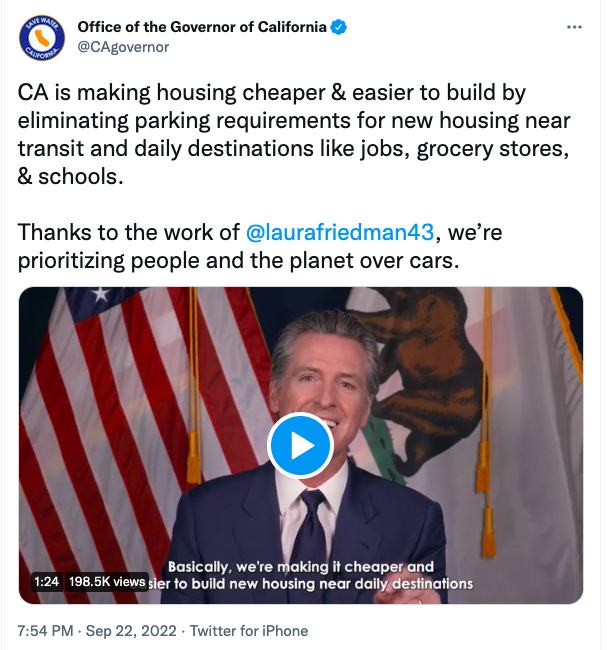The HomeWork: September 29, 2022

Welcome to the September 29, 2022 Main edition of The HomeWork, the official newsletter of California YIMBY — legislative updates, news clips, housing research and analysis, and the latest writings from the California YIMBY team.
News from Sacramento
The legislative session has come to a close and Governor Gavin Newsom has signed all of California YIMBY’s 2021 – 2022 priority housing legislation into law, capping a session that saw some of the most significant pro-housing reforms since the dawn of the YIMBY movement.
Last week, Gov. Newsom signed into law AB 2097,* a landmark bill that ends nearly a century of parking mandates in cities throughout the state. Authored by Assemblymember Laura Friedman (Glendale) and co-sponsored by California YIMBY, AB 2097 increases housing choice and will make it easier to provide lower-cost, walkable- and transit-accessible housing across the state.
Then this week, the Governor followed up by signing AB 2011, by Asm. Buffy Wicks – the most sweeping housing and land use reform of this session. It allows affordable housing to be built “by-right” in commercially-zoned districts, while including strong protections for the environment and labor standards such as prevailing wages and health insurance.
The Governor also signed SB 886* (Sen. Wiener), which streamlines student and faculty housing on land owned by the University of California, California State University, and community colleges; and AB 2221 (Asm. Quirk-Silva), which clarifies ADU law to make it faster and easier to build these popular “casitas.”
We’ll have more to say on these legislative wins and other policy developments after the deadline for bills passes on September 30, but for now, it’s the season of [Victory Alerts].
* indicates a bill is sponsored by California YIMBY
Housing Research & Analysis
It’s the Asphalt, Stupid: How Freeways Wrecked Local Economies
US Secretary of Transportation Pete Buttigieg recently announced a major federal grant for tearing down the one-mile I-375 freeway in Detroit, a monument to racial injustice that cut a deep scar through Black neighborhoods – and displaced 100,000 residents in its construction. Buttigieg also launched a $1 billion Reconnecting Communities grant program for similar efforts earlier this year.
The program has major racial justice implications for communities all across California, including Oakland’s I-980 and surrounding environs. As illustrated in a new working paper by Federal Reserve economists, federal investment in urban freeways divided communities and devastated local economies to enable subsidized access to the city for suburban commuters.
Key takeaways:
- By calibrating a model to Chicago as a case study, the authors found that freeways directly reduce quality of life for neighboring local residents, with net welfare costs “equivalent to about 5 percent of income.”
- The authors found that “one-third of the effect of freeways on central city population decline can be attributed to freeway disamenities” — negative externalities such as noise, pollution, and the physical “barrier effects” of freeways increasing local travel time.
- “Freeway revolts” that followed the initial wave of urban freeway projects in the 1950s were more likely to succeed in blocking or diverting freeways in wealthier, whiter neighborhoods with more political power.
Detroit’s War Against Our Kids
The United States is in the midst of a traffic violence epidemic, with motor vehicle collisions among the leading causes of death for children, and annual traffic deaths reaching 16-year highs. The increasing share of SUVs on the road is a major driver of this deadly crisis.
Edwards & Lenard (2022) at the University of Illinois at Springfield find evidence that SUVs have been significantly deadlier for pedestrians and cyclists than the average passenger vehicle since traffic fatalities began increasing in 2009.
Key takeaways:
- SUVs are eight times more likely to kill cyclist or pedestrian children in a collision than a passenger vehicle.
- Overall, SUVs are disproportionately deadly, accounting for less than 15 percent of all pedestrian/cyclist collisions and 25 percent of the fatal ones.
- Motor vehicles are also disproportionately killing Black pedestrians and cyclists.
Houser Headlines
- YIMBYs cheer ‘landmark’ law to eliminate parking mandates in housing near transit
- The Next Step on Climate Action: Parking Reform
- ‘Unwinding really backward policy:’ California abolishes decades-old parking requirements
- How to Fix the Housing Crisis with Brian Hanlon
- Why California’s Parking Reform Matters for Housing and Climate
- Op-Ed: Parking Reform Is California’s Most Important Climate Bill
- New Housing Bills Passed By California Legislature To Increase Affordable Housing
- Gimme Shelter: What would California look like with housing on commercial strips?
- Here’s the one thing San Francisco can teach California about building new housing
- New bills could ease rules on building and student housing. What does it mean for SLO County?
- Florida and the future of U.S. neighborhoods
- Los Angeles Homeless Service Authority Releases 2022 Homeless Count Results
YIMBY Social – Top Posts

Share the good word
We welcome your ideas and feedback — send story tips and ideas to Homework@cayimby.org.